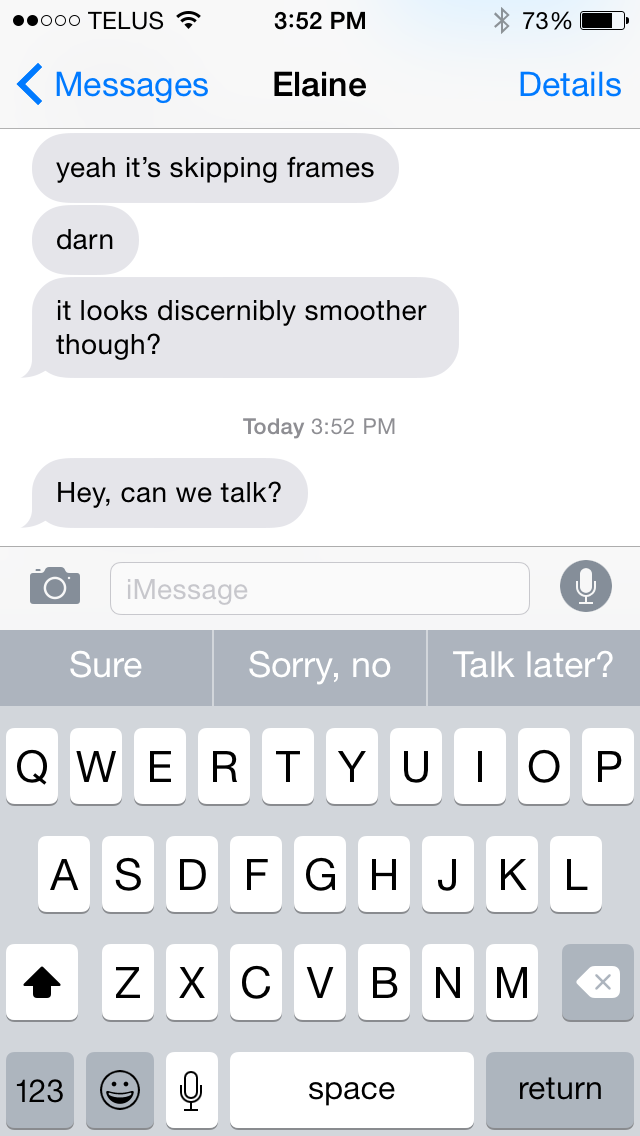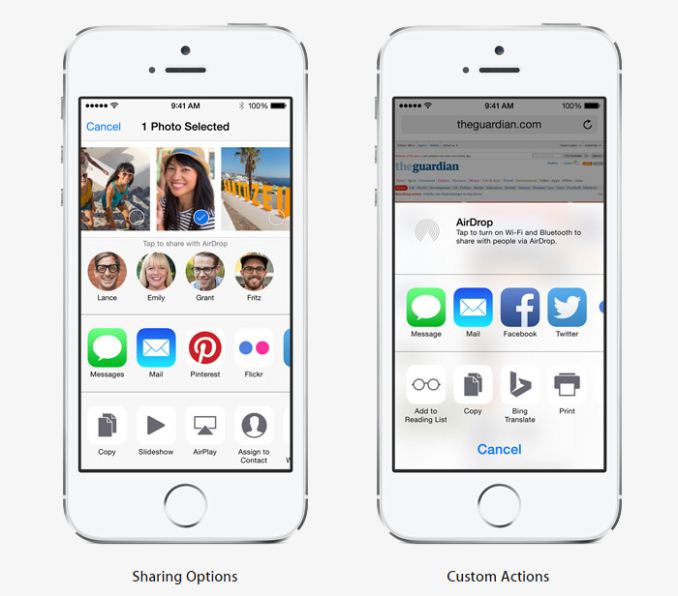The iOS 8 Review
by Brandon Chester on September 17, 2014 1:00 PM ESTKeyboard
For a long time the keyboard experience on iOS remained the same as it was when the original iPhone launched all the way back in 2007. With iOS 7 the keyboard received a visual overhaul, but the layout and correction functions remained the same. This has been a prominent criticism of the stock iOS keyboard over the years, with the single suggestion implementation of iOS's autocorrect seeming archaic compared to other smartphone keyboards. Apple addresses this with two solutions in iOS 8. The first is QuickType, Apple's new suggestion and correction feature.
The above two images will be instantly recognizable to anyone who has used the Google keyboard for Android, or third party keyboards like SwiftKey. The way quicktype functions is nearly identical to the suggestion feature on Google's and other smartphone keyboards. A bar above the keyboard gives three suggestions as the user types, with the box turning white and the text turning blue to indicate that a typed word will be autocorrected.
QuickType is not Apple's only solution to complaints about the iOS keyboard. While it offers a better method of correcting typos, the keyboard itself is still functionally identical to its predecessor. Because Apple can't possibly hope to address every single user's desire for keyboard input on their own, they have finally included the long requested ability to use third party keyboards on iOS 8. How keyboards and other extensibility options are implemented is discussed in the next section, but there are a couple of things specific to third party keyboards that should be noted.
The first is that third party keyboards will be system wide; there's no need for developers to implement them in their applications on their own. The second, and possibly most important, is that third party keyboards run in an extremely restrictive sandbox by default. They don't have access to the information from other applications on the phone, or access to WiFi or cellular networks. However, third party keyboards can ask for access to typed words and networking to do prediction, but for privacy and security reasons that is never something that can be enabled by default. I recently took a look at the beta version of SwiftKey for iOS 8, and you can read my impressions about the actual third party keyboard experience on iOS there.
One last point about the stock keyboard. The shift key is the same as on iOS 7.1. Users (like myself) that are frustrated with its new design as of iOS 7.1 are out of luck. A return to the iOS 7 style of having the shift key arrow as an outline when it is turned off is my biggest recommendation for improving the iOS keyboard from its current state.
Extensibility
When the iPhone was first launched, iOS wasn't even designed to support third party applications. Apple's original stated intent was that users would use web apps through Safari. Obviously things turned out quite differently with the introduction of iOS 2.0 and the App Store. However, iOS itself was never conceived with a massive library of native applications in mind. Because of that, and because of security reasons, each app has traditionally been completely segregated from all others.
Applications on iOS have never really had a proper way of sharing data and integrating with each other, with the exception of the select few services that Apple has built into iOS over the years like Facebook and Twitter. This has always posed a problem with working on files across multiple apps. It also greatly limits the ability to share content through other applications, as the iOS Share Sheet is limited to the services built into iOS unless a developer adds support for other applications on their own.
Extensibility changes this. Extensibility in iOS 8 is really an umbrella term for new features like share extensions, action extensions, custom photo filters, and document provider extensions. Some of these have been covered at other points in this review, and the parts being focused on here are Action Extensions and Share Extensions. Much like the improvements to iCloud, these are additions that are hard to talk about now as they are yet to be implemented by developers. This is just a small overview of things to come once developers start using the new tools given to them.
Action Extensions do what their name implies, they perform actions that extend the functions of applications. An example would be an extension for the Bing Translate app shown at WWDC. Rather than Apple having to work with Microsoft to make translation with Bing a system wide feature, Microsoft can simply make an Action Extension and have it appear in the Share Sheet in any application.
Share Extensions also do what their name implies. They allow applications to put their own options for sharing in the system's Share Sheet. This is a massive improvement over the previous system that only included limited options and the small handful of services that Apple had integrated into the OS like Twitter and Facebook. Share Extensions are very similar in function to how Intents are able to share files and content between different apps on Android, and it addresses what has been a major iOS shortfall for years. The example Apple gave at WWDC was the ability to open the Pinterest app interface within Safari to share a photo.
iOS also has contextual awareness relating to extensions. Because the Share Sheet can only display four icons in each row, only the extensions that relate to what the user is doing will be shown. If the user is looking at the photos application the Share Sheet won't show an extension for text translation as it doesn't relate to the task at hand. Apple also allows the order extensions are displayed in to be customized so that frequently used extensions are always displayed in the Share Sheet without having to scroll.
One final part of extensibility that pertains to iPhone 5s users is that developers are now able to use Touch ID authentication in their applications to unlock passwords stored as keychain items. The fingerprint data itself is never shared with applications, only whether or not the fingerprint was successfully identified or not.
As I said above, the iOS security model has always used application sandboxing to prevent malicious access to information. With extensibility you may be wondering if Apple has had to compromise on security to enable these new features. Fortunately, the answer is no. With the way extensions work on iOS 8, the extension is part of its parent application's container. Extensions can only reach out to other applications by way of the operating system, which has various checks and balances to make sure things are being done in a safe and secure manner. I don't believe users should have any concerns about the security of their devices when upgrading to iOS 8.













164 Comments
View All Comments
KoolAidMan1 - Thursday, September 18, 2014 - link
That's because iOS 8 is mostly an under the hood update for developers to further increase performance and functionality. SceneKit, Handoff, Metal API, etc.Tech stuff, not shiny gimmicks like we know you're into
Donkey2008 - Friday, September 19, 2014 - link
Oh look. Another smarty comment from an Android fanboy. Seems like its been 1-2 minutes since we heard one. Glad to know that the biggest douches on tech forums (Android owners) are still on top of their game.sprockkets - Saturday, September 20, 2014 - link
Sorry if you think that is a "smarty" comment from an Android owner.After 143 comments, as usual, darwinosx hasn't bothered to say one word of praise about this update, yet he/she will always be trolling any story about android or a device running it.
Grow some skin - darwinosx in comparison spews nothing but bullsht.
Axee7 - Tuesday, September 23, 2014 - link
DOn't buy iPhone 6 Plus.. Its huge and over thin and it get bent so easily.. I just saw horrifying pics here :( read more on AxeeTech dot comzepi - Wednesday, September 17, 2014 - link
"Not everyone has an Apple device and therefore not everyone has iMessage."And this renders whole iMessages almost useless. Why on earth would one use it in the first place when free crossplatform apps are available?
p_giguere1 - Wednesday, September 17, 2014 - link
Because you don't always know whether your recipient has the necessary app installed and their account info when necessary. For a lot of people you text and you are not necessarily very close to, it's just awkward/long to ask "Do you have Hangouts? What's your Google account?", so you'll just send a regular text. That's where iMessage is relevant. In this case, the question is more like "Why on earth would one NOT use it rather than a regular text", since it's literally as easy as sending a text and only have added benefits.Ancillas - Wednesday, September 17, 2014 - link
On an Android phone, Hangouts and SMS are integrated into one view, just like SMS and iMessage.The difference is that when I send a message from my iPhone to my buddy who has an Android phone, he can't use iMessage because he doesn't have Apple hardware. That's absurd. I'll just install Hangouts, and we get all the same features.
Along the same lines, if I want to have the ability to take my iMessage conversation off of my phone and on to my computer, then I have to have OS X. Again, that's crazy. Using Hangouts, I just hop on to a browser on any computer, and I have all my messages right there.
PalmOS did this right by putting Google messages inline with SMS messages (along with other providers). Apple could do this, but they won't because they want to protect their ecosystem. I will not endorse that closed-model design, even though I use iOS. I choose to use the Hangouts app in iOS, but I don't use Hangout for SMS (even though it is supported).
steven75 - Wednesday, September 17, 2014 - link
What's absurd is expecting everyone to have or create a Google account in order to use Hangouts. SMS is universally supported.Impulses - Wednesday, September 17, 2014 - link
SMS has many serious issues, it's time for something better... If iMessage supported a universal protocol it'd be the bomb, but Apple would never do that.cj100570 - Wednesday, September 17, 2014 - link
You must be confused, you don't have to create a Google account to use Hangouts for SMS. Never have. If you set Hangouts as your SMS app it merely takes the place of the default app.